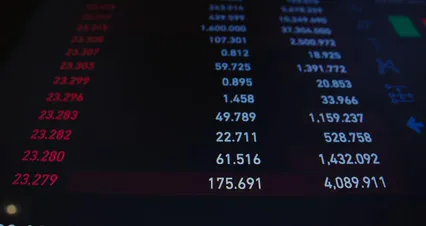Introduction
Basic Statistical Returns (BSR) are a crucial part of India’s banking framework. These returns help the Reserve Bank of India (RBI) maintain a watchful eye over the financial activities of banks. This system gathers vital data that aids in monitoring economic trends, ensuring stability, and facilitating effective monetary policies. Introduced in December 1972, the BSR system has evolved to meet the changing landscape of banking and finance in India.
The primary purpose of the BSR system is to collect and report statistical data from banks. This data encompasses aspects like loans, deposits, and financial transactions, contributing to a comprehensive overview of the banking sector. By analyzing this information, the RBI can identify patterns, assess risks, and make informed decisions to bolster the economy.
One of the key components of the BSR system is the BSR code, a unique seven-digit identifier assigned to each bank branch. The first three digits represent the bank, while the last four indicate the specific branch. This code is crucial for various banking operations, including tax filings. It allows banks to track tax payments and report them accurately to the Income Tax Department, making it a valuable tool for both banks and taxpayers.
Speaking of taxes, if you want to understand the nitty-gritty of tax compliance in India, grab a copy of Understanding Tax Compliance in India. This book is a lifesaver for navigating the complexities of tax laws and ensuring you stay on the right side of the law.
BSR codes play a significant role in tax compliance and financial reporting. They ensure that all transactions are recorded systematically, making it easier for the Income Tax Department to verify tax payments. Additionally, BSR codes help streamline banking operations and enhance transparency, fostering a more reliable financial environment.
This article aims to provide an in-depth understanding of BSR codes, their classifications, uses, and benefits. By the end, readers will appreciate how BSR codes facilitate smoother financial transactions and support the overall health of the Indian banking system.

Understanding basic statistical returns is essential for grasping the banking framework in India. Basic Statistical Returns
Understanding BSR Codes
What is a BSR Code?
A BSR code is a seven-digit identifier assigned to banks by the RBI. The structure of the code is simple yet effective: the first three digits represent the bank, and the last four identify the specific branch. Each bank branch has its unique BSR code, allowing for clear tracking of transactions and financial reporting.
BSR codes are vital for maintaining accurate banking records. They play a crucial role in tax filings, enabling banks to report Tax Deducted at Source (TDS) and Tax Collected at Source (TCS) returns. By using BSR codes, banks can ensure their records align with the requirements set by the Income Tax Department, promoting transparency and compliance.
If you want to dive deeper into the world of finance, check out The Basics of Banking and Finance. This book is perfect for beginners and offers a solid foundation for understanding the financial system.
In addition to tax-related purposes, BSR codes facilitate efficient tracking of online payments. When individuals make tax payments through banks, the corresponding BSR code is recorded, ensuring a smooth flow of information between banks and tax authorities. This system not only enhances accountability but also helps prevent fraud in tax filings.
Historical Context
The BSR system was introduced by the RBI in December 1972, marking a significant step towards organized banking data collection. Initially, it aimed to improve the statistical reporting of banking data, allowing for better insight into the health of the banking sector. Over the decades, this system has evolved to include various categories of data, reflecting changes in the economy and banking practices.
In its early years, the BSR system focused on gathering basic statistics related to loans and deposits. However, as the banking landscape transformed, the scope of the BSR system expanded. By adapting to new challenges and incorporating modern data collection methods, the RBI has ensured the continued relevance of the BSR system in today’s fast-paced financial environment.
As we look at the evolution of BSR codes and their significance, it becomes clear that they are not just numbers. They represent a commitment to transparency and a robust banking framework. The BSR system continues to play an essential role in the development of the Indian banking sector, facilitating growth and stability while ensuring compliance with regulatory standards.
In summary, understanding BSR codes and their historical context is vital for grasping their importance in the Indian banking system. These codes support not only tax compliance but also contribute to the overall health of the economy by enabling better tracking and reporting of financial activities.

Uses of BSR Codes
Primary Applications
BSR codes, or Basic Statistical Return codes, serve as vital tools in the Indian banking landscape. These unique seven-digit identifiers are essential for filing TDS (Tax Deducted at Source) and TCS (Tax Collected at Source) returns. For many, this may sound like another bureaucratic hurdle, but fear not! This code is more than just a number; it’s your ticket to ensuring a smoother tax filing process.
When taxpayers make online tax payments, the associated BSR code helps banks record these transactions accurately. Imagine trying to find a needle in a haystack; that’s what it’s like for the Income Tax Department without BSR codes. They rely on these codes to track payments and verify compliance. Thus, BSR codes streamline the entire process, making it easier for both banks and taxpayers to maintain clear records.
Moreover, BSR codes play a critical role in ensuring that the Income Tax Department receives accurate information about online payments. This transparency helps mitigate the risk of tax evasion, thereby benefiting the entire financial ecosystem. In short, BSR codes are not only useful for filing returns but also for fostering a culture of accountability in tax payments.
BSR Codes in Documentation
BSR codes are prominently featured in several important documents. You can typically find them on:
- Challan Identification Number (CIN): The CIN is a unique 20-digit code assigned to each tax payment. The BSR code forms an integral part of this number, helping to identify the bank branch where the payment was made.
- TDS Certificates: These certificates provide proof of tax deducted at source. The BSR code included in these documents makes it easier for taxpayers to reference their payments.
- OLTAS Challan: The Online Tax Accounting System (OLTAS) challan is another document where you’ll see BSR codes. It simplifies the tax payment process and helps in tracking payments.
Let’s consider a few scenarios where BSR codes are necessary. Imagine you are a pensioner eagerly waiting for your monthly pension. To receive your dues without a hitch, you need to provide your BSR code along with your bank account details. This allows the bank to process your pension application swiftly and accurately.
Another scenario involves tax returns. If you’ve made a tax payment through your bank, you’ll need the BSR code to report this in your income tax return. Without the correct code, your payment might not get credited, leading to unnecessary delays and complications.
In conclusion, BSR codes are not just random numbers; they are pivotal in facilitating efficient tax processes and ensuring accurate financial reporting. Whether in your tax returns or pension processing, these codes help maintain order in the often chaotic world of finance. So, the next time you see a BSR code, remember its significant role in making banking and taxation smoother for everyone involved.

Classifications of BSR Codes
Understanding the classifications of Basic Statistical Returns (BSR) codes can help demystify their role in banking and finance. The Reserve Bank of India (RBI) has categorized BSR codes into seven distinct types, each serving a unique purpose in the financial landscape. Let’s break them down, shall we?
BSR 1: Half-yearly Return on Advances
BSR 1 is like the bank’s report card for advances. This half-yearly return is submitted on the last Friday of June and December, capturing all advances made by branches. It’s split into two parts: Part I for accounts exceeding Rs. 10,000 and Part II for those under. Think of it as a way for the RBI to assess how much lending is happening out there.
BSR 2: Half-yearly Return on Deposits
Now, onto BSR 2! This code tracks deposits in a similar manner to BSR 1, but instead, it focuses on the money flowing into banks. Also submitted on the last Friday of June and December, this return provides insights into how much cash customers trust banks with. It’s a key indicator of banking health, reflecting public confidence in the financial system.
BSR 3: Monthly Advances Against Sensitive Commodities
BSR 3 steps into the spotlight with its focus on sensitive commodities. This monthly return captures advances made against these commodities, reported on the last Friday of each month. It helps the RBI keep an eye on sectors that could impact the economy significantly, such as agriculture and essential goods. After all, if the farmers thrive, we all benefit!
BSR 4: Ownership of Bank Deposits
Every two years, banks must submit BSR 4, providing ownership details of their deposits. This return is submitted on the last Friday of March and reveals who holds the money. Whether it’s individuals, companies, or government entities, this information is crucial for understanding the depositor landscape. It acts as a snapshot of where the money resides in the banking community.
BSR 5: Annual Return on Bank Investments
BSR 5 is the annual report card on bank investments. Submitted on the last day of March, this return provides a comprehensive overview of a bank’s investments. It details how much money is allocated in various securities and other investment vehicles. This information is vital for assessing the investment strategies of banks and their financial health.
BSR 6: Quinquennial Survey on Debits
Every five years, banks complete BSR 6, a quinquennial survey focused on debits. This survey provides insights into the volume and types of debits to deposit accounts over the past financial year. By collecting this data, the RBI can analyze trends in consumer spending and banking behaviors, helping to shape monetary policy.
BSR 7: Quarterly Survey on Aggregate Deposits and Credit
Lastly, we have BSR 7. This quarterly survey, submitted on the last Fridays of June, September, December, and March, aggregates data on deposits and credit. It provides a holistic view of the banking sector’s performance, allowing the RBI to gauge overall liquidity in the market. This code is essential for understanding the banking system’s capacity to support economic growth.
Conclusion
Each classification of BSR codes plays a vital role in the banking sector. They help the RBI monitor financial conditions, assess risks, and develop policies that support economic stability. By understanding these classifications, we get a clearer picture of how banks operate and contribute to the economy. Whether it’s lending, deposits, or investments, BSR codes provide the necessary insights to keep our financial system robust and responsive.

Benefits of Using BSR Codes
Advantages for Taxation and Banking
Basic Statistical Returns (BSR) codes might seem like just another set of numbers in the banking world, but they pack a punch when it comes to taxation and banking benefits. Let’s break down how these little codes make a big difference.
First, BSR codes are essential for tax tracking and compliance. They are like the trusty sidekick of the Income Tax Department. When taxpayers make online payments, the BSR code ensures that these transactions are recorded accurately. This means less chance for errors and more transparency. Taxpayers can effortlessly verify their payments, ensuring that they don’t end up in a sticky situation come tax season.
For banks, the benefits of BSR codes are equally significant. They help maintain clear transaction records, making audits a breeze. Imagine trying to find a single grain of sand on a beach. That’s how challenging it can be to navigate banking transactions without BSR codes. With these codes, banks can easily track each transaction, ensuring compliance with tax laws and enhancing accountability.
But wait, there’s more! BSR codes are a boon for senior citizens when it comes to pension disbursements. Pensioners need to provide their BSR code along with their bank details to ensure timely payments. This simple requirement helps prevent delays and guarantees that pensions reach their rightful owners without a hitch. After all, who wants to wait for their hard-earned money?
If you’re curious about personal finance management, consider checking out Financial Literacy for Beginners. This book is a great starting point for anyone looking to build a solid foundation in managing their money.
In summary, BSR codes serve as a vital tool for both taxpayers and banks. They streamline tax tracking, enhance compliance, and ensure that seniors receive their pensions promptly. These codes are not just numbers; they are the backbone of efficient banking and taxation systems.

BSR Codes vs. IFSC Codes
While both BSR codes and IFSC codes are essential in the banking landscape, they serve different purposes and have distinct structures. Let’s lay it all out in a neat comparison table.
| Feature | BSR Code | IFSC Code |
|---|---|---|
| Length | 7 digits | 11 characters |
| Purpose | Tax tracking and reporting | Unique identification of bank branches |
| Structure | First 3 digits: bank, last 4: branch | First 4 characters: bank, 5th is “0”, last 6: branch |
| Usage | TDS/TCS returns | RTGS, NEFT, and other payment methods |
| Issued by | Reserve Bank of India | Reserve Bank of India |
While BSR codes help with tax-related processes, IFSC codes play a crucial role in electronic fund transfers. The former is mainly used for filing returns, while the latter is vital for making real-time transactions. In a nutshell, BSR codes help keep the taxman happy, while IFSC codes ensure your money zips around the banking system without a hitch.
In essence, understanding the differences between BSR and IFSC codes is key for anyone navigating the Indian banking landscape. Each serves its purpose, ensuring that our financial transactions remain smooth and compliant.

Challenges and Opportunities
Current Challenges
Despite the numerous advantages of BSR codes, several challenges persist. One of the most significant issues is awareness. Many banking professionals and even taxpayers are not fully educated on the functionality of BSR codes. This knowledge gap can lead to misunderstandings and errors in tax filing.
Technological integration is another challenge. As the banking industry evolves, integrating BSR codes into newer systems can pose difficulties. Banks are constantly upgrading their technology, and ensuring that BSR codes are seamlessly incorporated is essential for maintaining accurate records.
Furthermore, there are concerns about the accuracy of data reporting. If banks do not report transactions correctly, it can create discrepancies in tax records. This can lead to compliance issues and may even result in penalties.
Lastly, compliance with BSR requirements can sometimes feel like a daunting task for banks. With numerous codes and classifications to manage, maintaining accuracy while meeting deadlines can be a juggling act.
However, these challenges also present opportunities for improvement. Increased awareness initiatives can educate both banks and taxpayers about the importance of BSR codes. Additionally, leveraging technology can enhance the efficiency of data reporting and integration.
Future Opportunities
The Basic Statistical Returns (BSR) system holds great potential for future advancements. For starters, embracing technology could vastly improve efficiency. Imagine a digital platform that allows banks to input data in real time. This would reduce delays and enhance data accuracy, making compliance a breeze.
Moreover, the Reserve Bank of India (RBI) could introduce automated alerts for banks. These alerts would notify them of upcoming deadlines for BSR submissions. Timely reminders would help banks avoid last-minute scrambles and potential penalties.
Another opportunity lies in the integration of artificial intelligence. AI could analyze BSR data to identify trends and anomalies. This would empower banks to make informed decisions while ensuring compliance with regulatory requirements.
If you’re interested in personal finance strategies, I highly recommend The Total Money Makeover by Dave Ramsey. This book offers practical advice on budgeting and debt elimination.
Additionally, enhancing the utility of BSR codes is crucial. Banks could collaborate with the RBI to streamline the code assignment process. By simplifying how codes are assigned and used, banks could reduce administrative burdens.
Implementing a feedback mechanism for banks would also be beneficial. Gathering insights from banks regarding BSR code usability would help the RBI make necessary adjustments. This collaborative effort would foster a more efficient system that meets the needs of all stakeholders involved.

Conclusion
In conclusion, understanding Basic Statistical Returns (BSR) codes and their implications is essential for taxpayers, banks, and financial professionals alike. BSR codes not only facilitate tax compliance but also play a pivotal role in ensuring a well-organized banking system. They enable the Reserve Bank of India to monitor financial health effectively, allowing for better policy decisions.
The BSR system has undergone significant evolution since its inception in 1972. Its importance continues to grow with changing economic landscapes and technological advancements. By recognizing the role of BSR codes, stakeholders can appreciate how they contribute to the overall stability of the financial system in India.
For taxpayers, BSR codes simplify the process of filing returns. They ensure that payments are accurately recorded and reported to the Income Tax Department. This transparency benefits everyone involved, reducing the likelihood of errors and promoting compliance.
Banks, on the other hand, rely on BSR codes for efficient record-keeping and reporting. They help maintain accurate transaction histories, which are crucial for audits and regulatory compliance. Improved clarity in transactions leads to trust and reliability in the banking sector.
As we move forward, it is essential to encourage further exploration of BSR codes. Financial professionals should stay updated on developments related to these codes and their impact on the financial landscape. By doing so, they can better serve their clients and contribute to a more robust economic environment.
In summary, BSR codes are more than just numbers; they are a foundation for transparency, accountability, and growth in the Indian banking system. As we embrace the future, focusing on innovations and improvements in the BSR system will pave the way for a thriving financial ecosystem.

FAQs
What is a Challan Identification Number (CIN)?
A Challan Identification Number (CIN) is a unique 20-digit code assigned to tax payments made through banks. It helps identify the specific transaction and includes the BSR code, date of deposit, and challan number.
How can I find my BSR code?
You can find your BSR code on various documents such as TDS certificates and OLTAS challans. Alternatively, banks often provide this information on their websites or upon request.
Is there a difference between BSR code and branch code?
Yes, there is a difference. The BSR code is a 7-digit code assigned by the RBI for tax tracking, while the branch code is part of the IFSC code used for electronic fund transfers.
Do all branches of a bank have the same BSR code?
No, each branch has a unique BSR code. The first three digits identify the bank, while the last four digits specify the individual branch.
How is the BSR code used in tax filings?
The BSR code is essential for filing TDS and TCS returns. It ensures accurate reporting of tax payments made through banks, helping the Income Tax Department verify compliance with tax laws.
Please let us know what you think about our content by leaving a comment down below!
Thank you for reading till here 🙂
All images from Pexels




